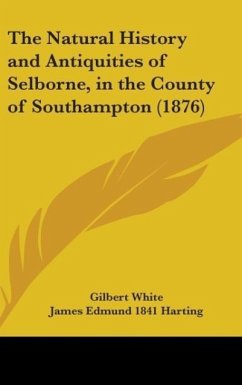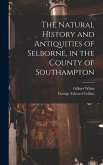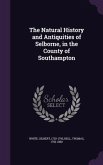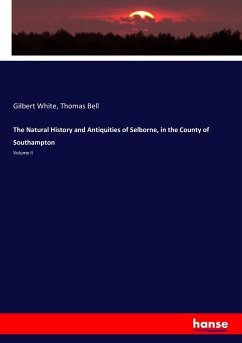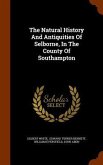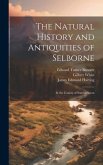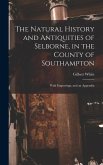Gilbert White
The Natural History And Antiquities Of Selborne, In The County Of Southampton (1876)
Herausgeber: Harting, James Edmund
Gilbert White
The Natural History And Antiquities Of Selborne, In The County Of Southampton (1876)
Herausgeber: Harting, James Edmund
- Gebundenes Buch
- Merkliste
- Auf die Merkliste
- Bewerten Bewerten
- Teilen
- Produkt teilen
- Produkterinnerung
- Produkterinnerung
This book is a facsimile reprint and may contain imperfections such as marks, notations, marginalia and flawed pages.
Andere Kunden interessierten sich auch für
![The Natural History and Antiquities of Selborne, in the County of Southampton The Natural History and Antiquities of Selborne, in the County of Southampton]() Gilbert WhiteThe Natural History and Antiquities of Selborne, in the County of Southampton42,99 €
Gilbert WhiteThe Natural History and Antiquities of Selborne, in the County of Southampton42,99 €![The Natural History and Antiquities of Selborne, in the County of Southampton The Natural History and Antiquities of Selborne, in the County of Southampton]() Gilbert WhiteThe Natural History and Antiquities of Selborne, in the County of Southampton40,99 €
Gilbert WhiteThe Natural History and Antiquities of Selborne, in the County of Southampton40,99 €![The Natural History and Antiquities of Selborne, in the County of Southampton The Natural History and Antiquities of Selborne, in the County of Southampton]() Gilbert WhiteThe Natural History and Antiquities of Selborne, in the County of Southampton30,90 €
Gilbert WhiteThe Natural History and Antiquities of Selborne, in the County of Southampton30,90 €![The Natural History And Antiquities Of Selborne, In The County Of Southampton The Natural History And Antiquities Of Selborne, In The County Of Southampton]() Gilbert WhiteThe Natural History And Antiquities Of Selborne, In The County Of Southampton43,99 €
Gilbert WhiteThe Natural History And Antiquities Of Selborne, In The County Of Southampton43,99 €![History Of The Intellectual Development Of Europe V2 (1876) History Of The Intellectual Development Of Europe V2 (1876)]() John William DraperHistory Of The Intellectual Development Of Europe V2 (1876)45,99 €
John William DraperHistory Of The Intellectual Development Of Europe V2 (1876)45,99 €![The Natural History and Antiquities of Selborne: In the County of Southampton The Natural History and Antiquities of Selborne: In the County of Southampton]() James Edmund HartingThe Natural History and Antiquities of Selborne: In the County of Southampton42,99 €
James Edmund HartingThe Natural History and Antiquities of Selborne: In the County of Southampton42,99 €![The Natural History and Antiquities of Selborne, in the County of Southampton: With Engravings, and an Appendix The Natural History and Antiquities of Selborne, in the County of Southampton: With Engravings, and an Appendix]() Gilbert WhiteThe Natural History and Antiquities of Selborne, in the County of Southampton: With Engravings, and an Appendix42,99 €
Gilbert WhiteThe Natural History and Antiquities of Selborne, in the County of Southampton: With Engravings, and an Appendix42,99 €-
-
-
This book is a facsimile reprint and may contain imperfections such as marks, notations, marginalia and flawed pages.
Produktdetails
- Produktdetails
- Verlag: Kessinger Publishing, LLC
- Seitenzahl: 592
- Erscheinungstermin: 2. Juni 2008
- Englisch
- Abmessung: 235mm x 157mm x 39mm
- Gewicht: 1102g
- ISBN-13: 9781436670500
- ISBN-10: 1436670500
- Artikelnr.: 24690051
- Verlag: Kessinger Publishing, LLC
- Seitenzahl: 592
- Erscheinungstermin: 2. Juni 2008
- Englisch
- Abmessung: 235mm x 157mm x 39mm
- Gewicht: 1102g
- ISBN-13: 9781436670500
- ISBN-10: 1436670500
- Artikelnr.: 24690051
Gilbert White FRS (18 July 1720 - 26 June 1793) was a "parson-naturalist", a pioneering English naturalist, ecologist and ornithologist. He is best known for his Natural History and Antiquities of Selborne. White is best known for his The Natural History and Antiquities of Selborne (1789). This is presented as a compilation of his letters to Thomas Pennant, the leading British zoologist of the day, and the Hon. Daines Barrington, an English barrister and another Fellow of the Royal Society, though a number of the 'letters' such as the first nine were never posted, and were written especially for the book.[16] The book has been continuously in print since its first publication.[17] It was long held, "probably apocryphally", to be the fourth-most published book in the English language after the Bible, the works of Shakespeare, and John Bunyan's The Pilgrim's Progress White's biographer, Richard Mabey, praises White's expressiveness: What is striking is the way Gilbert [White] often arranges his sentence structure to echo the physical style of a bird's flight. So 'The white-throat uses odd jerks and gesticulations over the tops of hedges and bushes'; and 'Woodpeckers fly volatu undosu [in an undulating flight], opening and closing their wings at every stroke, and so are always rising and falling in curves. White has often been seen as an amateur 'country writer', especially by the scientific community. However, he has been called 'the indispensable precursor to those great Victorians who would transform our ideas about life on Earth, especially in the undergrowth - Lyell, Spencer, Huxley and Darwin.'[20] And he is under-rated as a pioneer of modern scientific research methods, particularly fieldwork.[21] As Mabey argues, the blending of scientific and emotional responses to Nature was White's greatest legacy: 'it helped foster the growth of ecology and the realisation that humans were also part of the natural scheme of things.

